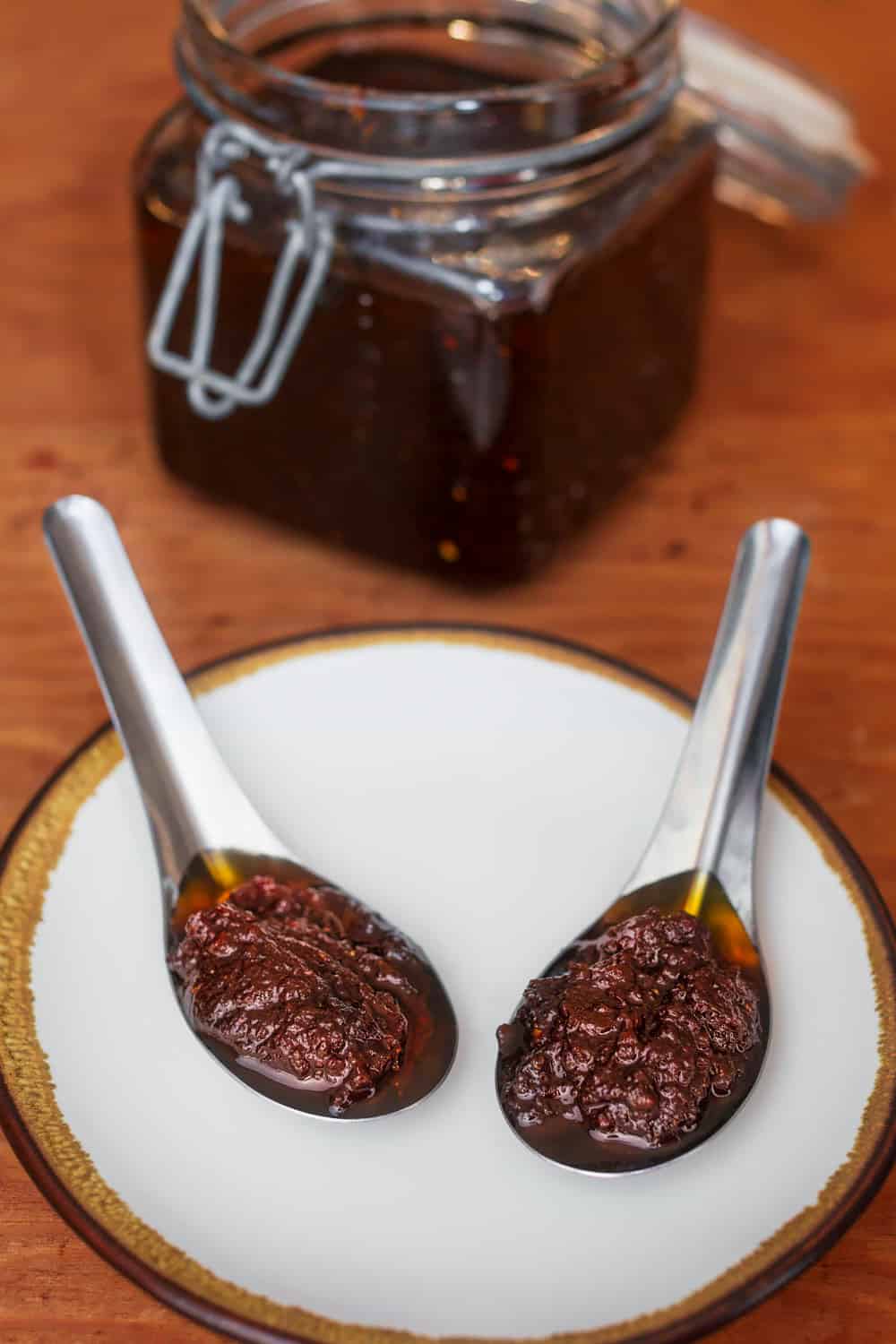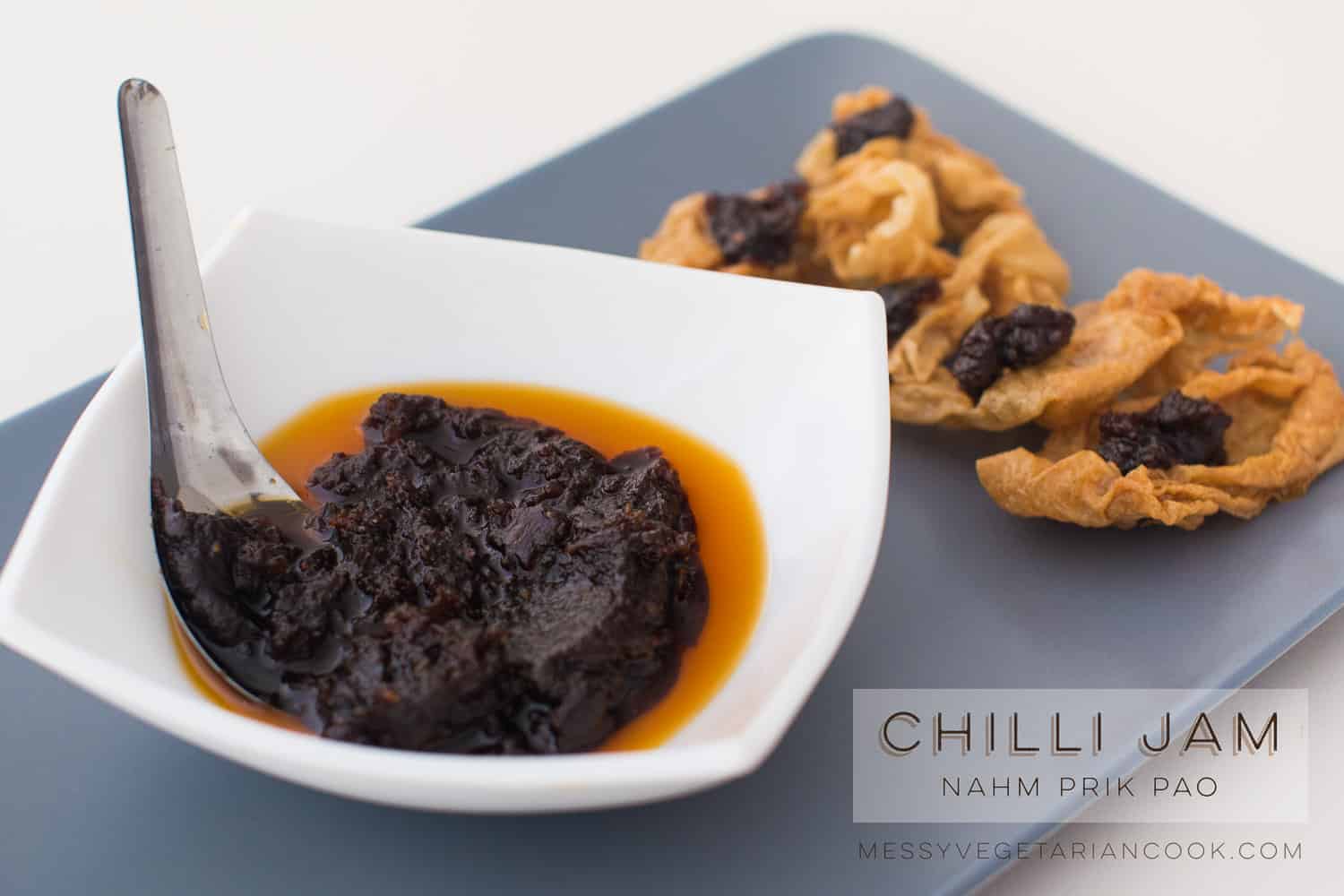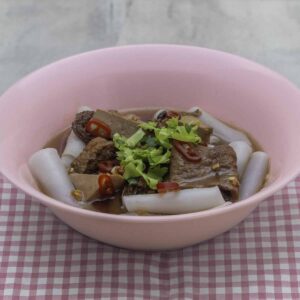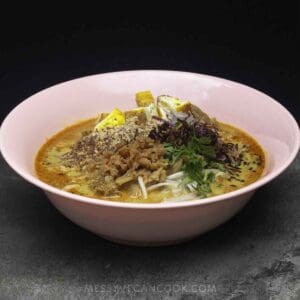Add this extraordinary vegan nam prik pao chilli jam to just about anything for an added wow factor (it's great on toast). I would like to spread it on my life.

This is also the sort of foodstuff that, once jarred up and labelled, makes a thoughtful gift. If you use a mason jar, however, be sure to photograph it with your feet somehow in the picture (ideally the person behind the camera will have a waxed moustache). Then use the most unappealing filter you can find before uploading the photo to Instagram. If you are sitting down, be sure to use the #whatveganseat hashtag. Get it?

📖 Recipe
Vegan nam prik pao (Thai chilli jam)
Ingredients
- 80 millilitres hot water ⅓ cup
- 3 tablespoons tamarind pulp from a block See notes
- 250 millilitres vegetable oil 1 cup
- 100 grams thinly sliced shallots 1 cup
- 50 grams garlic cloves, peeled and roughly chopped ⅓ cup
- 4 thin slices galangal 5-6 grams
- 5 dried long red chillies, deseeded
- 7 grams fine sea salt or table salt 1 teaspoon
- 65 grams soft light palm sugar packed ¼ cup
Instructions
- Mash the tamarind and warm water together in a small bowl. Use a mesh strainer to strain the liquid into another container by pressing the pulp firmly against the mesh with the back of a wooden or silicone spoon. You'll end up with about 80 millilitres (⅓ cup) of tamarind liquid.
- Set aside a plate to hold each ingredient after it's fried. Don't worry about using kitchen roll to drain away excess oil.
- Bring the oil in a wok to medium heat. Tip the shallots into the oil and fry, stirring often, until they are toasty brown in colour (but not burnt) and crispy. Pay special attention to the edges of the oil, where the ingredients tend to darken more quickly than in the centre of the wok. The shallots should take 10-15 minutes to prepare. Use a mesh skimmer to remove the shallots to the prepared plate.
- Next add the garlic to the oil and cook in the same way until the slivers are lightly brown (somewhere around 5 minutes, depending on how hot the oil is). Remove to the plate.
- The galangal will take less time to cook than the shallots and garlic. Fry the slices until they are shriveled and brown around the edges, just a minute or so. Remove to the plate.
- Finally, fry the dried chillies until they turn a deeper red (30 seconds to 1 minute). As with all other ingredients, do not burn before removing to the plate.
- Once everything is fried, pound the salt and fried chillies with a pestle and mortar into a smooth paste. Add the fried galangal and pound until broken down. Continue with the garlic and then shallots until everything is pulverized and combined into a paste.
- Heat 2 tablespoons of the frying oil in a smaller pan. Add the prepared tamarind liquid, the pounded paste, and palm sugar. Cook for 10 minutes on medium-low heat, stirring regularly. The paste will thicken slightly in the pool of oil. Allow to cool before use.
- The oil will be flavoured with all of the ingredients you fried in it, so save it for use in dressings and other cooking applications (or for future frying).









Hannah says
Could you use tamarind concentrate instead? What would the amount be?
Kip says
Hi Hannah,
Yes, this should work fine. The quality of the concentrates is not always a good, so I would start with a 1:1 quantity and then taste to see if you personally think it needs more.
Jeff B says
Hi,
Great recipe, thanks for posting it! Question—do you know of any vegetarian/vegan brands of fish sauce available in the US? I usually use light soy, but I know it just isn’t the same.
Thanks!
Kip says
Hi Jeff, glad you liked the recipe. As for fish sauce brands in the US I would stick with Vietnamese imports. I've only tried one of the US ones (Ocean's Halo) and it was not good IMO. As a salty sauce, it was fine, but as fish sauce no way. Any Vietnamese brand that contains just soy and salt (maybe some other things, but definitely not sugar, seaweed, vinegar etc...) is going to be your best bet. Lucky Tree brand used to be imported and sold in some places in the US, but I've no idea what's available now... Let me know if you find anything!
Daniel says
Super Q has the best vegan fish sauce I have ever found (the only vegan fish sauce I have ever liked). It is a bit difficult to find and I have yet to locate it online. I used to buy it in Asian markets in San Antonio, but since moving back north, no luck. There is a vegetarian fish saice redily availible by super Q up here, but it is of the sweet persuasion with added chilli. The vegitarian fish sauce that smells and tastes quite close to the real thing only has soy, wheat, and salt listed in the ingredients. If I could post a pic I would. Good luck in your search.
Kip says
Thanks for the recommendation. Hopefully that will be helpful to my North American readers.
Daniel says
Thank you for this recipe. What a treat to pair with sticky rice!!
Liz R says
do you have any recommendations for what kind of chilies? I assume they're supposed to be bigger than the Thai chilies, but I don't know what kind to get
Kip says
Hi Liz, apologies for the delay in responding to your comment. Dried Thai chillies come in many varieties but you're likely to find just one or two types outside of Thailand. I wouldn't use bird's eyes. Look for something that's a bit bigger. Thai supermarkets will sell what you need. The standard dried Thai chillies for sale in these shops tend to be 2-3 inches long. Failing this you can use larger dried chillies from a Chinese market. Or, if you're somewhere that sells Mexican ingredients, dried puya chillies are a decent stand in.
I reserve the right to improve malicious and trollish comments.